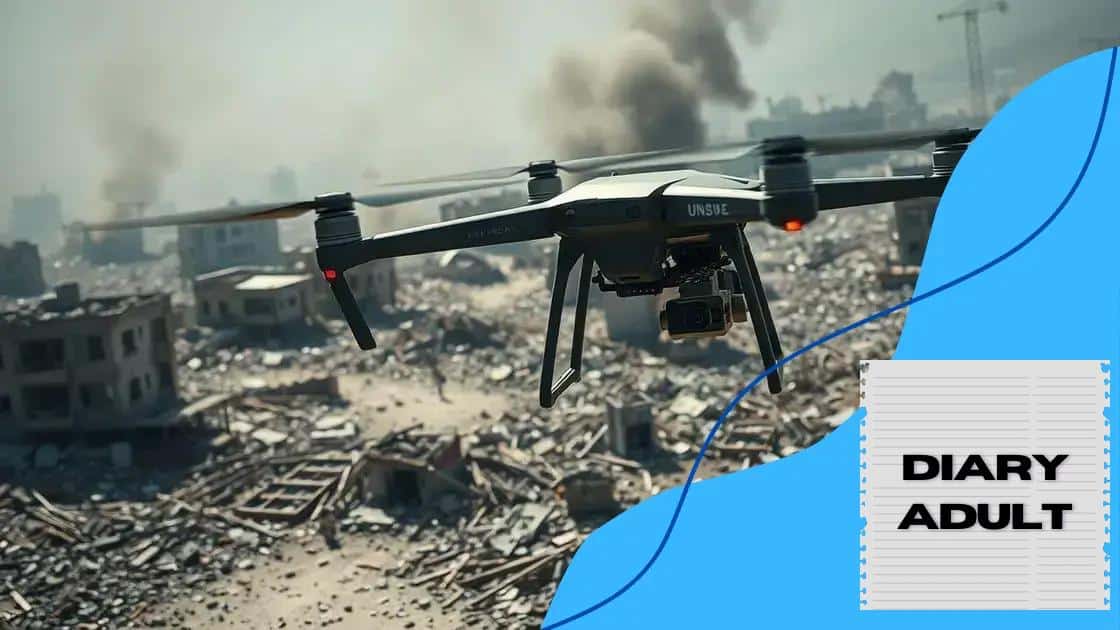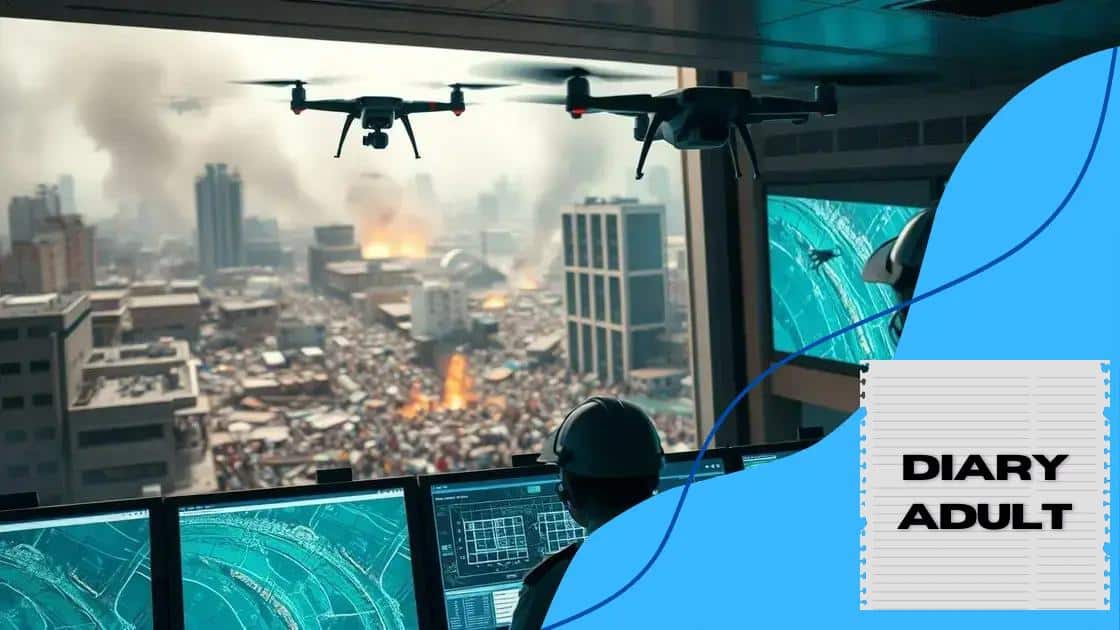Drones used in disaster recovery operations: a game changer

Drones used in disaster recovery operations enhance situational awareness and improve response efficiency by providing real-time data, aerial surveys, and advanced mapping capabilities, despite facing regulatory and technical challenges.
Drones used in disaster recovery operations are transforming the way we respond to crises. Ever wondered how these high-tech devices can save lives and resources in the wake of disasters? Let’s dive into their impactful role.
Understanding the role of drones in disaster recovery
Understanding the role of drones in disaster recovery is essential for efficient emergency response. Drones provide unique capabilities that enhance the effectiveness of disaster relief efforts.
These unmanned aerial vehicles can rapidly survey disaster zones. They gather valuable data, helping responders to gain important insights. Drones can reach areas that are unsafe or difficult for humans to access. This ability makes them invaluable in crisis situations.
Key functions of drones
Drones serve various purposes in disaster recovery. Here are some primary functions they perform:
- Damage assessment: Drones provide aerial views of affected areas, allowing responders to understand the extent of destruction.
- Search and rescue: Drones equipped with thermal imaging can locate stranded individuals in hard-to-reach places.
- Supply delivery: In emergencies, drones can deliver medical supplies and food to isolated communities.
Besides these functions, drones also help in mapping and documenting the disaster’s impact. Geographic Information Systems (GIS) can analyze this data to plan effective recovery strategies. By utilizing drone technology, organizations can improve coordination among teams.
As technology continues to advance, the role of drones in disaster recovery will likely expand. Innovations may lead to even more sophisticated equipment and software tools. Understanding how to leverage these advancements is critical for future emergency management.
Benefits of using drones in emergency situations
Using drones in emergency situations offers numerous advantages that significantly enhance response efforts. These innovative devices provide rapid access to critical data, making rescue operations more efficient.
Drones can quickly cover large areas, which is vital during disasters. They enable emergency responders to gather real-time information from above without endangering personnel. This capability allows teams to assess the situation more effectively.
Improved situational awareness
One of the key benefits of drones is their ability to provide detailed aerial views. This helps responders understand the scale of destruction. With high-resolution cameras, drones capture images and videos for analysis.
- Quick data collection: Drones gather information faster than traditional methods.
- Enhanced mapping: They create accurate maps for planning rescue operations.
- Better visibility: Drones can fly above obstacles, offering a clear view of affected areas.
Another benefit is the capability of drones to operate in hazardous environments. They can reach locations that are unsafe for human rescuers. This feature makes them particularly useful during floods, fires, and earthquakes. In these situations, drones can deliver supplies, such as food and medical kits, directly to those in need.
Moreover, using drones reduces costs associated with emergency response. They require less manpower and can cut down on fuel expenses for ground vehicles. Organizations can allocate more resources to aid and recovery while maintaining efficiency.
How drones enhance situational awareness

Drones play a vital role in enhancing situational awareness during emergency situations. Their aerial perspective allows responders to see what is happening in real time, which is crucial when every second counts.
With advanced sensors and cameras, drones collect data that ground teams may not easily access. This information helps in identifying hazards, simulating scenarios, and making informed decisions quickly. Drones can take off and capture images or videos within minutes, significantly speeding up assessments.
Real-time data collection
One essential aspect of drones is their ability to capture real-time data.
- Live stream capabilities: Drones can broadcast live feeds to command centers, allowing decision-makers to monitor situations remotely.
- Thermal imaging: This feature helps locate heat signatures, identifying people or equipment in low visibility conditions.
- Mapping technology: Drones can create 2D and 3D maps of affected areas, aiding in a comprehensive assessment.
Moreover, drones can fly over dangerous terrains, such as flooded areas or fire zones, without putting human lives at risk. Their agility means they can quickly adjust to conditions as they change, giving responders the information they need to adapt their strategies. Having drones on site increases the safety of rescue operations, allowing teams to approach challenges with greater confidence.
By employing drone technology, organizations can enhance their situational analysis significantly. This leads to more efficient resource allocation and improves the overall effectiveness of emergency responses.
Key technologies in drone operations
The world of drone operations is enriched by various key technologies that enhance their effectiveness in emergency situations. Understanding these technologies can help organizations maximize their use during disaster recovery.
One important technology is the GPS navigation system. This system allows drones to fly accurately to designated locations. It is vital for tasks such as mapping and surveying disaster areas. Drones use GPS to create flight paths and gather data efficiently.
Advanced sensor technology
In addition to GPS, drones are equipped with advanced sensors that collect critical data.
- Infrared sensors: These help to detect heat signatures, making it easier to find individuals trapped during disasters.
- LiDAR (Light Detection and Ranging): This technology captures high-resolution, 3D images of the terrain, assisting in creating accurate maps for relief efforts.
- Multispectral cameras: These cameras can assess vegetation health and identify areas in need of urgent assistance.
Another key technology is real-time data transmission. Drones can send live video feeds back to command centers, enabling immediate decision-making by emergency responders. This capability enhances coordination and speeds up the response time during crises.
Autonomous flight systems are also noteworthy. They allow drones to follow predefined paths or operate without direct human control. This technology reduces the risk of human error, particularly in high-pressure situations. With these systems, drones can perform complex missions while minimizing the need for on-site operators.
Challenges and future of drones in disaster recovery
The use of drones in disaster recovery is not without its challenges. Despite their advantages, there are several obstacles that organizations must overcome to maximize the potential of these technologies.
One significant challenge is regulatory restrictions. Many countries have strict laws governing drone operations, which can hinder timely deployment during emergencies. Navigating these regulations requires careful planning and coordination with local authorities.
Technical limitations
Another challenge involves technical limitations. Drones often depend on battery life and weather conditions. For instance, heavy rain, strong winds, or extreme temperatures can affect their performance. This restrictiveness may limit their usefulness in certain disaster scenarios.
- Battery life: Many drones can only operate for a short period before needing to recharge.
- Payload capacity: Drones may be limited in the amount of equipment or supplies they can carry.
- Signal loss: Poor connectivity can disrupt data transmission, leading to incomplete information.
Despite these challenges, the future of drones in disaster recovery looks promising. Advancements are constantly being made to enhance their capabilities. Innovations in battery technology, miniaturization of sensors, and improvements in artificial intelligence will likely make drones more efficient and versatile.
Furthermore, the integration of drone technology with other tools like AI and machine learning can enhance decision-making processes based on analyzed data. Companies are also exploring the use of swarms, where multiple drones work together to cover larger areas more effectively. This collaborative model could revolutionize how we deploy drones for rescue and recovery operations.
The use of drones in disaster recovery is rapidly transforming emergency response efforts. While challenges such as regulatory restrictions and technical limitations exist, the benefits of enhanced data collection and improved situational awareness are significant. The future of drone technology looks bright, with advancements that promise to overcome current obstacles. As drones become more integrated into response operations, they will continue to save lives and aid recovery efforts more effectively.
Key Points:
🚁 Drones Enhance Response: Provide real-time data collection and improved situational awareness.
⚖️ Regulatory Challenges: Navigating strict laws can delay deployment in emergencies.
🔋 Technical Limitations: Battery life and weather can impact drone performance.
🚀 Future Innovations: Advancements promise to enhance capabilities and overcome obstacles.
🤝 Improved Collaboration: Integration with AI and machine learning enhances decision-making.
FAQ – Frequently Asked Questions about Drones in Disaster Recovery
What are the main benefits of using drones in disaster recovery?
Drones enhance situational awareness, provide real-time data collection, and improve response time during emergencies.
What challenges do drones face in emergency situations?
Drones can encounter regulatory restrictions, technical limitations such as battery life, and adverse weather conditions.
How do drones improve situational awareness for responders?
Drones provide aerial views and real-time data, allowing responders to assess damage and prioritize rescue operations quickly.
What technologies are essential for drone operations in disaster recovery?
Key technologies include GPS navigation systems, advanced sensors, real-time data transmission, and autonomous flight systems.





